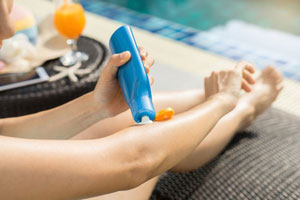What You Need to Know about Sunscreen

SPF, UVA, UVB, what does it all mean and why is it so important when selecting your sunscreen? If you find yourself asking the question, you are not alone. According to the latest research, most people don’t understand everything written on the sunscreen label. So, today, let’s take a few minutes to explore the intricacies of sunscreen.
SPF – Sun Protection Factor
The Sun Protection Factor, commonly referred to as SPF, is a measure of sunscreen protection related to UVB (ultraviolet-B) rays. SPF doesn’t measure for protection of UVA (ultraviolet-A) rays. Both UVA and UVB, as types of radiation, are damaging and dangerous to your skin. The SPF measurement tells wearers how well, as well as how long, a sunscreen can protect you from the suns radiation. Experts, as in physicians and dermatologists, recommend the use of a SPF15 or SPF30 sunscreen, as research suggests higher SPFs don’t provide much additional protection. For example, SPF15 blocks 93 percent of the UVB rays, while SPF30 blocks 97 percent and SPF50 blocks 98% of the UVB rays. Now, in real time, if you burn easily in the sun, say after only 10 minutes for example, and you apply an SPF15 sunscreen you could stay in the 150 minutes without burning (10 x 15). This is only an estimate because your skin type, along with the intensity of the sunlight on a given day and the amount of sunscreen applied can make all the difference.
UVB Rays
As mentioned, the SPF in your sunscreen measures its ability to filter out the sun’s UVB rays, the ones that cause sunburn and skin cancer. Sunburn results in damage to your skin’s surface epidermal layers. UVB rays also are key in the development of skin cancer. Generally, UVB rays in the United States are strongest between April and October, from 10 in the morning to 4 in the afternoon but they can damage your skin all year long.
UVA Rays
UVA rays make up 95 percent of the sun’s ultraviolet radiation reaching the earth. Even though they not as strong as UVB rays, they are up to 50 times more common, penetrating clouds and glass, and exhibiting the same strength all year long. UVA penetrates your skin more deeply, causes aging, wrinkling, and skin cancers. Recent studies have linked UVA rays to basal and squamous cell carcinomas. UVA is the tanning ray, both outdoors and in tanning salons, with tanning booths delivering UVA 12 times greater that the strength of the sun and increasing the risk of melanoma, basal cell carcinoma, and squamous cell carcinoma.
Choosing and Using Your Sunscreen
While experts recommend SPF15 and SPF30, only sunscreen labeled broad spectrum offers protection for both UVB and UVA rays. If you choose a sunscreen without the broad spectrum label, chances are you are only getting UVB protection, not both. Generally, sunscreens shield only against UVB. The American Academy of Dermatology recommends choosing a sunscreen with SPF30 that delivers broad spectrum protection and is water resistant.
You should apply your sunscreen 15 minutes before going outside. Your application should use a generous portion, which for adults is approximately one ounce. Less and you won’t get the protection you need! Cover your entire body – neck, face, ears, legs, back, tops of feet, etc. Apply SPF15 or stronger balm to your lips. If you have thinning hair, don’t forget to apply sunscreen to your head or wear a hat. Your sunscreen should be reapplied every two hours, especially after periods of swimming or sweating. Sunscreens have expiration dates, don’t use expired sunscreen.
Sunscreen is the first steps in sun safety, so choose it wisely – SPF30, water resistant, broad spectrum – and put it on!
